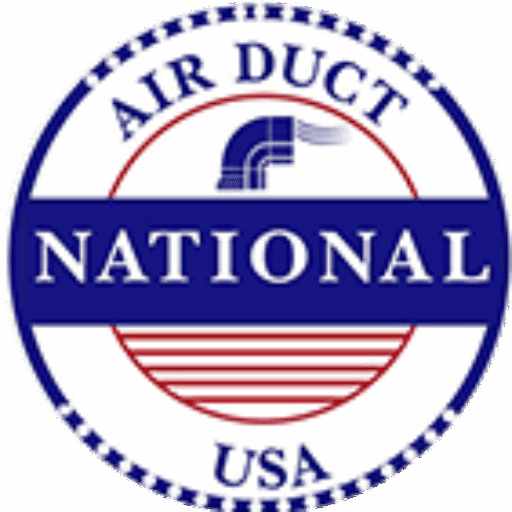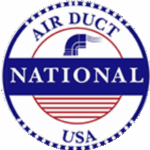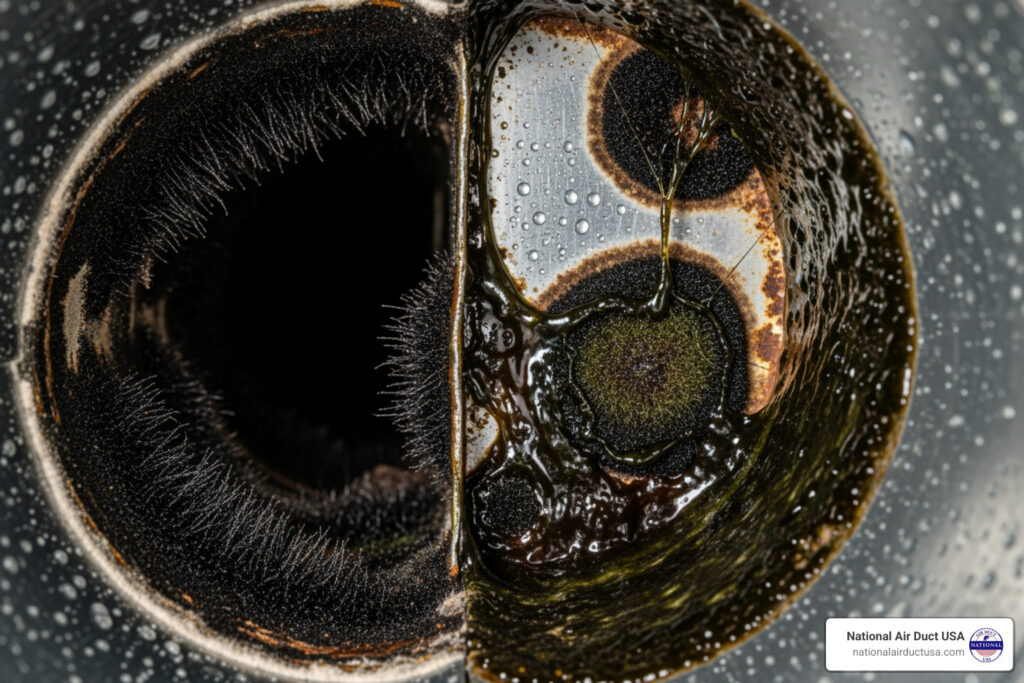The Hidden Health Threat Lurking in Your Home’s Air System
Mold in hvac ducts is a common but serious problem, posing risks to your health and your HVAC system’s efficiency. Here’s a quick overview:
Quick Answer: Key Facts About HVAC Duct Mold
- Signs: Persistent musty smell, visible black/green spots on vents, worsening allergy symptoms indoors.
- Causes: Moisture from condensation, high humidity (above 60%), clogged drains, and poor ventilation.
- Health Risks: Coughing, sneezing, headaches, respiratory issues, and worsening asthma.
- Action: Turn off your HVAC system immediately if you suspect mold and call a professional for areas larger than 10 sq. ft.
- Prevention: Keep humidity below 50%, change filters regularly, and ensure proper drainage.
That musty smell when your AC or heat kicks on isn’t just stale air; it could be mold spores circulating through your Long Island home. Your ductwork is a perfect breeding ground for mold: it’s dark, often damp from condensation, and collects dust that mold uses as food. When your system runs, it spreads these spores into the air you breathe.
Fortunately, mold in HVAC ducts is both preventable and treatable. This guide will show you how to identify, eliminate, and prevent mold, protecting your family’s health and avoiding costly HVAC repairs.
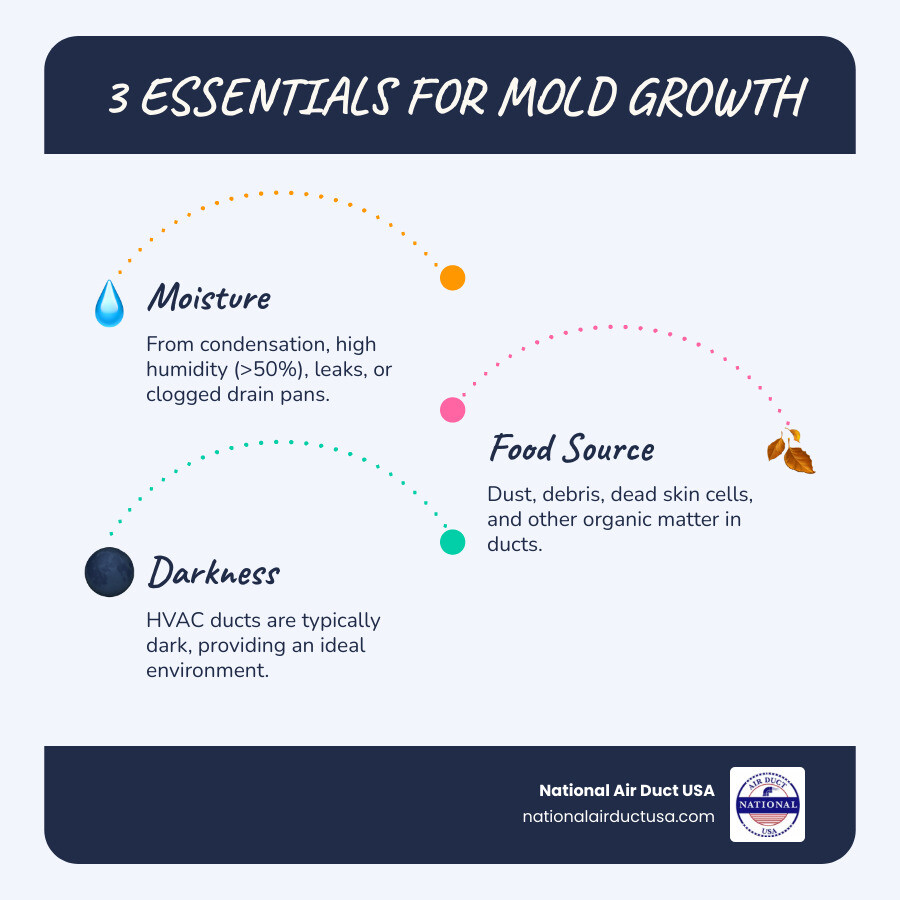
Detective Work: How to Identify Mold in Your HVAC System
That earthy, musty odor in your home isn’t just unpleasant—it’s often the first warning sign of mold in hvac ducts. The smell comes from microbial volatile organic compounds (mVOCs) released by mold. Beyond the smell, you can also use your eyes and pay attention to your health to spot the problem.
Common Signs of Mold in HVAC Ducts
- Persistent Musty Odor: The most common sign. If the smell is strongest when your heating or cooling system turns on, the HVAC system is likely circulating moldy air throughout your Long Island home.
- Visible Signs: Look for black or green spots or fuzzy patches around air vents, on registers, or inside the ductwork. What appears to be dust could be mold, especially if it feels slimy or wet.
- Health Symptoms: Unexplained allergy flare-ups are a major red flag. This includes persistent coughing, sneezing, a stuffy nose, itchy eyes, or skin irritation. Headaches, fatigue, and breathing difficulties can also indicate mold exposure. For those with worsening asthma or other respiratory conditions, the link to your HVAC system can be serious.
Visual Inspection: Where to Look for Mold
Check these common hiding spots for mold:
- Air Vents and Registers: Remove a vent cover and use a flashlight to inspect the inside of the duct opening. Look for black, green, or yellowish particles.
- Drip Pans: Located beneath the evaporator coil, these pans catch condensation. If clogged or angled incorrectly, standing water creates a perfect mold habitat.
- Evaporator Coils: These coils produce condensation to cool the air. If they are dirty or drainage is poor, moisture clings to them, encouraging mold growth.
- Visible Ductwork: Inspect any accessible ducts in your attic, basement, or utility closets for discoloration, water stains, or fuzzy growth.
- Condensation: Excessive moisture around ducts or vents is a warning sign of high humidity or poor insulation, both of which invite mold.
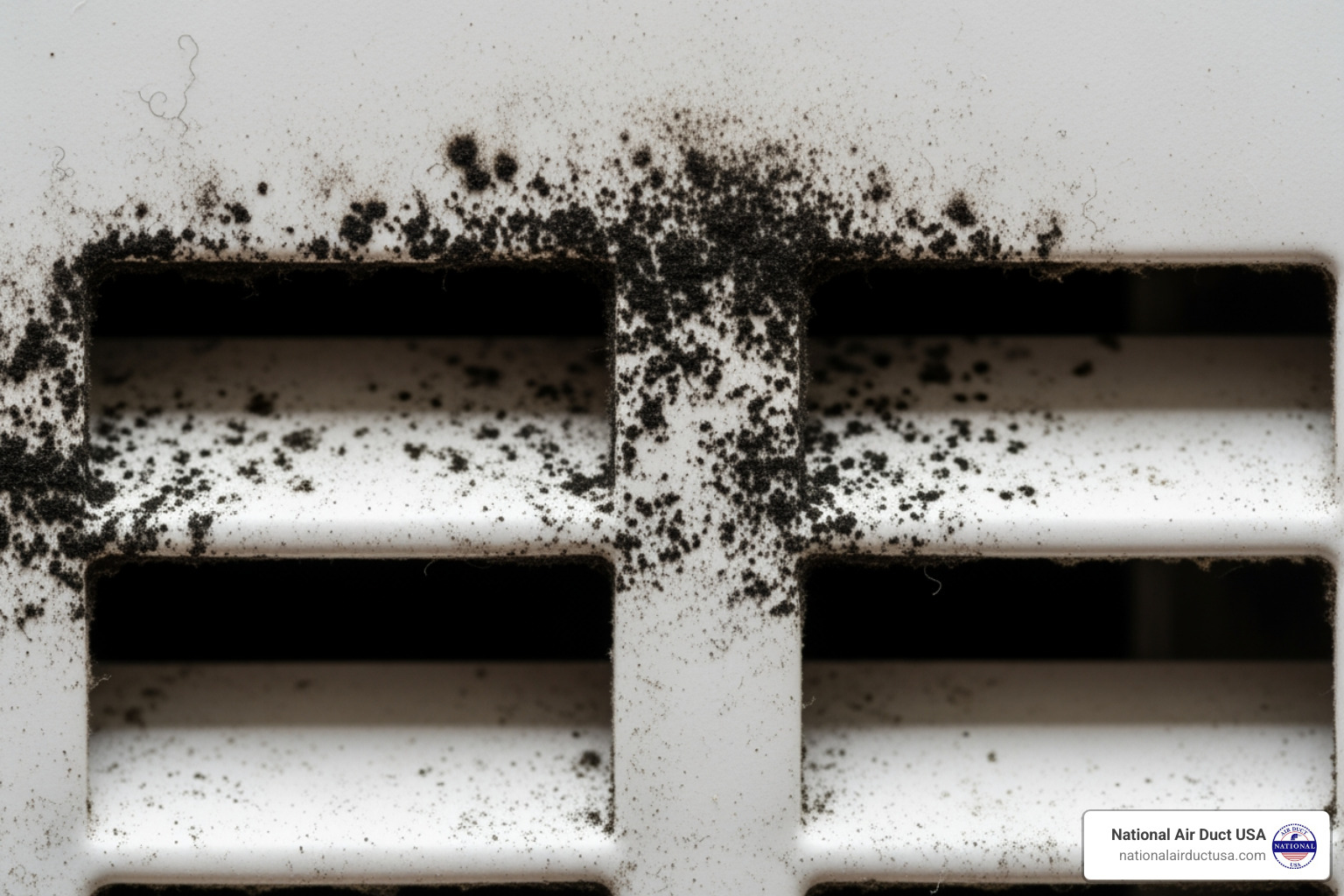
When to Call a Professional for Mold Testing
Distinguishing mold from dust can be difficult. If you suspect mold, especially if you see widespread growth or experience persistent health symptoms, it’s time to call a professional. A qualified inspector can take samples for lab analysis to confirm the presence and type of mold.
The EPA recommends professional remediation for mold covering more than 10 square feet. A lab report provides clear evidence of the problem and the necessary steps for removal.
For comprehensive inspections in Long Island, Nassau County, and Suffolk County, National Air Duct USA can help you breathe easier.
The Root of the Problem: What Causes Mold in HVAC Ducts?
Mold in your HVAC system isn’t a mystery; it grows from a simple recipe: moisture, a food source (like dust), and darkness. Your ductwork provides all three, creating an ideal environment for mold in hvac ducts to thrive.

How Moisture and Humidity Create a Breeding Ground
Moisture is the key ingredient for mold growth. In Long Island, where summer humidity is high, HVAC systems create many opportunities for moisture to accumulate.
- High Indoor Humidity: When humidity is consistently above 60% (ideal is 30-50%), moisture condenses on the cool surfaces inside your air ducts.
- Condensation & Drainage Issues: Your evaporator coils naturally produce condensation. If the AC drain pan is clogged with debris, this water becomes stagnant, creating a swamp-like environment perfect for mold.
- Leaks: Leaks in your ductwork or roof can introduce water directly into the system, creating damp spots that attract mold.
- Oversized HVAC Unit: An AC unit that’s too large for your home cools the space too quickly and shuts off before it can properly dehumidify the air. This short-cycling leaves excess humidity in your ductwork.
- Clogged Air Filters: Dirty filters restrict airflow, which can trap moisture in the system and create the damp conditions mold loves.
The Impact on Your HVAC System’s Health and Efficiency
Beyond health concerns, mold in hvac ducts seriously harms your HVAC system and your budget.
- Reduced Airflow: As mold and debris build up, they narrow the ducts, forcing your system to work harder. This leads to less effective heating and cooling.
- Clogged Components: Mold on evaporator coils and filters compromises their function, leading to poor air quality and reduced cooling capacity.
- Component Corrosion: The moisture that feeds mold can also cause metal parts in your HVAC system to rust and deteriorate, shortening its lifespan.
- Increased Energy Bills: A struggling system consumes more energy to maintain the desired temperature, leading to higher utility bills.
- System Strain: All this extra work wears out components faster, increasing the risk of breakdowns and premature system replacement.
Addressing moisture issues and keeping ducts clean is crucial for homeowners in Nassau and Suffolk County to protect their health and their HVAC investment.
Your Action Plan: Removing Mold from Your Air Ducts
If you find mold in your HVAC system, your first step is to turn off the system immediately. This stops it from spreading more spores throughout your home. Before investigating, wear proper safety gear: an N95 mask, gloves, and eye protection.
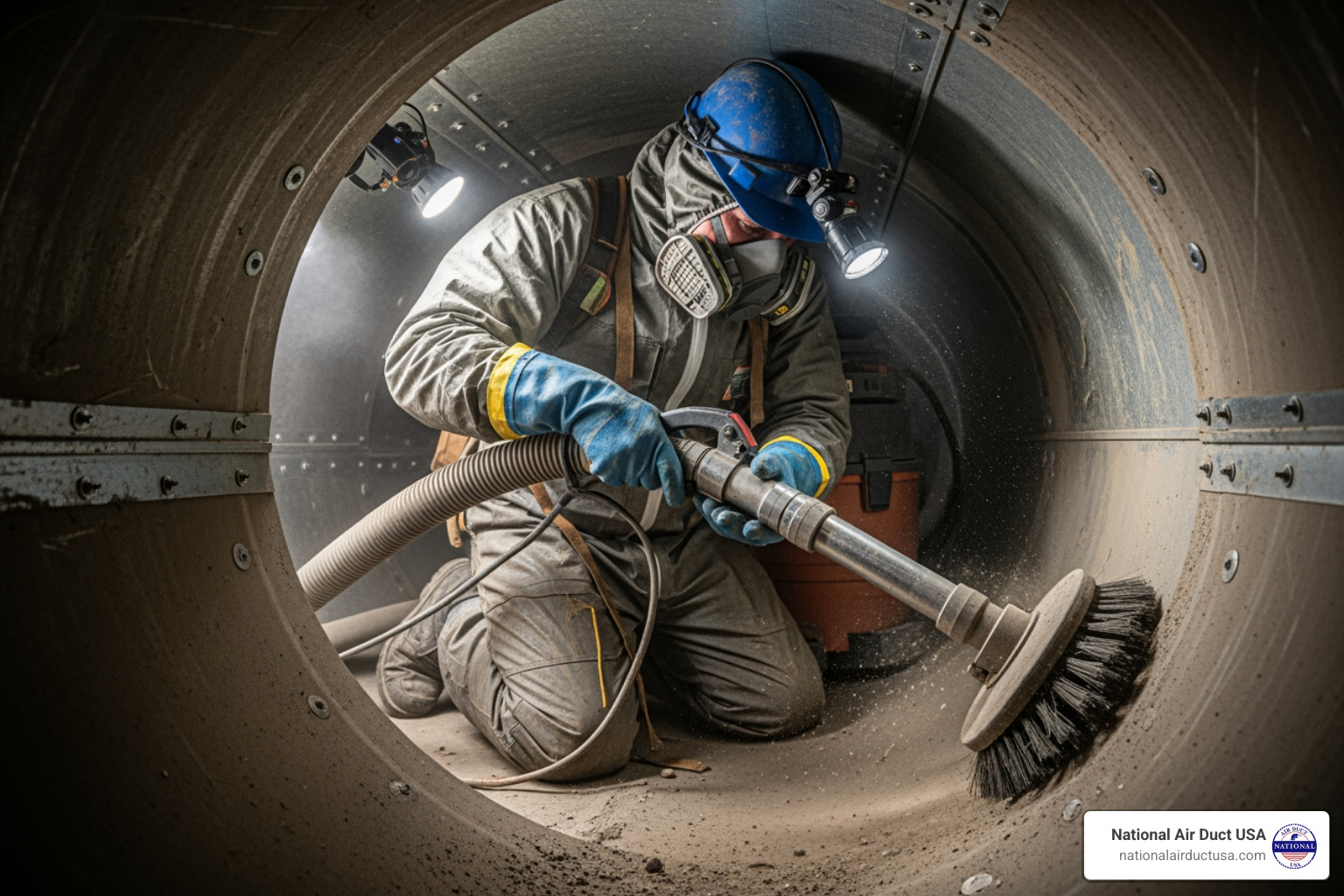
DIY Cleaning vs. Professional Remediation
While the EPA suggests DIY cleaning is possible for moldy areas under 10 square feet, mold in hvac ducts is a different challenge. Your ductwork is a complex network, and cleaning it without professional equipment often dislodges and spreads spores, making the problem worse. A household vacuum can’t capture microscopic spores and will blow them back into the air.
Visible mold on a vent is often just the tip of the iceberg, with the main colony hidden deep inside. For these reasons, professional remediation is the safest and most effective solution for most Long Island homeowners. You can learn more about our approach on our services page.
The Professional Process for Removing Mold in HVAC Ducts
When you hire certified professionals like our team at National Air Duct USA, we follow a systematic process based on NADCA standards for air duct cleaning:
- Containment: We set up containment barriers to prevent spores from escaping into your living areas.
- Negative Air Pressure: Specialized equipment creates negative pressure in the ducts, ensuring all dust and spores are pulled into a HEPA filtration system, not pushed into your home.
- Agitation and Removal: Powerful HEPA vacuums and specialized brushes scrub and remove all mold, dust, and debris from the duct surfaces. This physical removal is critical.
- Antimicrobial Treatment: After cleaning, we apply an EPA-approved antimicrobial agent to hard-surface ducts to kill remaining spores and inhibit future growth.
- Final Inspection: We conduct a thorough final check to ensure the system is completely clean and safe.
What to Do About Mold in Insulated Air Ducts
Many homes, especially older ones in Long Island, have ducts made from or lined with fiberglass insulation. If this porous material becomes moldy, it cannot be cleaned and must be replaced. This is a firm guideline from both NAIMA (the North American Insulation Manufacturers Association) and NADCA.
Fiberglass acts like a sponge, trapping mold deep within its fibers where cleaning is impossible. Attempting to clean it will damage the insulation and fail to remove the mold, which will simply grow back. While replacement is more involved, it’s the only way to permanently solve the problem and protect your family’s health.
Proactive Prevention: Keeping Your Ducts Mold-Free for Good
After eliminating mold in hvac ducts, proactive prevention is key to keeping it from returning. A few consistent habits can keep your system clean, dry, and mold-free, resulting in healthier air and lower energy bills.
For more on this topic, see our article on Why Regular Air Duct Cleaning is Essential for Every Home in Long Island and Westbury.
The Critical Role of Regular HVAC Maintenance
Consistent maintenance is your best defense against mold.
- Change Air Filters Regularly: Swap filters every 1-3 months. Clean filters prevent the buildup of dust, which is a food source for mold, and ensure proper airflow.
- Schedule Annual Professional Inspections: A trained technician can spot potential moisture issues before they become mold problems. Our NADCA-certified technicians at National Air Duct USA serve homes across Nassau and Suffolk County.
- Clean Coils and Drain Pans: During maintenance, ensure evaporator coils and drain pans are cleaned. This removes standing water and clogs, eliminating a primary breeding ground for mold.
- Ensure Proper System Function: A well-maintained, correctly sized HVAC system will manage humidity effectively, reducing the condensation that leads to mold.
Advanced Solutions for a Mold-Resistant Home
For an extra layer of protection, consider these advanced strategies:
- UV Light Installation: Installed near the evaporator coil, UV lights continuously kill airborne mold spores, bacteria, and viruses as they circulate through the system, preventing them from settling and growing.
- Ductwork Sealing: Leaky ducts can pull in humid, moldy air from attics or crawl spaces. Sealing them saves energy and keeps moisture and spores out of your system.
- Proper Duct Insulation: Insulating ducts in unconditioned spaces like attics prevents condensation from forming on their exterior.
Here are three key prevention tips:
- Control Humidity: Keep indoor humidity between 30% and 50%. Use a dehumidifier if necessary, especially during humid Long Island summers.
- Fix Leaks Promptly: Immediately address any water leaks from plumbing, the roof, or the HVAC system. Dry water-damaged areas within 24-48 hours.
- Ensure Good Ventilation: Use exhaust fans in bathrooms and kitchens to remove moisture and ensure adequate airflow throughout your home.
These proactive steps will help your HVAC system run more efficiently and, most importantly, ensure your family breathes cleaner, healthier air.
Frequently Asked Questions about HVAC Duct Mold
We hear many questions from Long Island homeowners about mold in hvac ducts. Here are answers to some of the most common concerns.
What are the main health effects associated with mold in air ducts?
Mold exposure affects people differently. For many, it triggers allergy-like symptoms such as coughing, sneezing, a stuffy nose, itchy eyes, and skin irritation. Other common effects include persistent headaches and difficulty breathing indoors.
The health risks are more serious for children, the elderly, and those with compromised immune systems. For individuals with asthma, mold can trigger attacks and severe respiratory distress. The EPA provides comprehensive information on mold and health, and we urge homeowners in Nassau and Suffolk County to take these symptoms seriously.
Can I just spray bleach into my ducts to kill mold?
No. Spraying bleach into your ducts is ineffective and dangerous. Here’s why:
- It’s Ineffective on Porous Surfaces: Bleach cannot penetrate porous materials like fiberglass duct liner, so it won’t eliminate the mold at its root. The mold will likely grow back.
- It Creates Harmful Fumes: Your HVAC system will circulate harsh bleach fumes throughout your home, causing respiratory irritation.
- It Can Damage Your Ducts: Chemicals can corrode metal ducts and degrade other components, leading to more expensive repairs.
- It Doesn’t Remove the Allergen: Even if bleach kills the mold, the dead spores remain and can still trigger allergic reactions. The EPA states that physical removal is essential.
Safe, professional remediation is the only way to properly handle mold in your ducts.
How often should I have my air ducts professionally cleaned?
The EPA does not recommend cleaning ducts on a fixed schedule, but rather “as needed.” You should schedule a professional cleaning if:
- You see visible mold growth inside your ducts or on other HVAC components.
- Your ducts have been contaminated by water damage from a flood or leak.
- You find your ducts are infested with rodents or insects.
- There is excessive dust and debris visibly blowing out of your supply vents.
- Your family is experiencing unexplained allergy symptoms or illnesses that you suspect are linked to your home’s air quality.
For homes in Long Island, regular visual checks and awareness of your indoor air quality will tell you when it’s time to call us at National Air Duct USA.
Conclusion: Breathe Easier with a Clean, Healthy Home
You now know that mold in hvac ducts is a serious threat to your family’s health and your HVAC system’s efficiency. More importantly, you know how to identify, remove, and prevent it.
The key takeaways are simple: identify the problem early, remediate it properly, and prevent it from coming back. Regular HVAC maintenance, including changing filters and scheduling annual inspections, is not just about saving on energy bills—it’s about protecting the air your family breathes.
At National Air Duct USA, our NADCA-certified technicians restore peace of mind to homeowners across Long Island, Nassau County, and Suffolk County by improving indoor air quality. We provide transparent pricing, reliable service, and treat your home with the care it deserves.
Your home should be a sanctuary, free from worry about air quality. Whether you have a current mold issue or want to be proactive, we are here to help. For a comprehensive inspection and professional cleaning backed by our 100% satisfaction guarantee, explore our HVAC and Air Duct Services today. Everyone deserves to breathe easier in a clean, healthy home.
